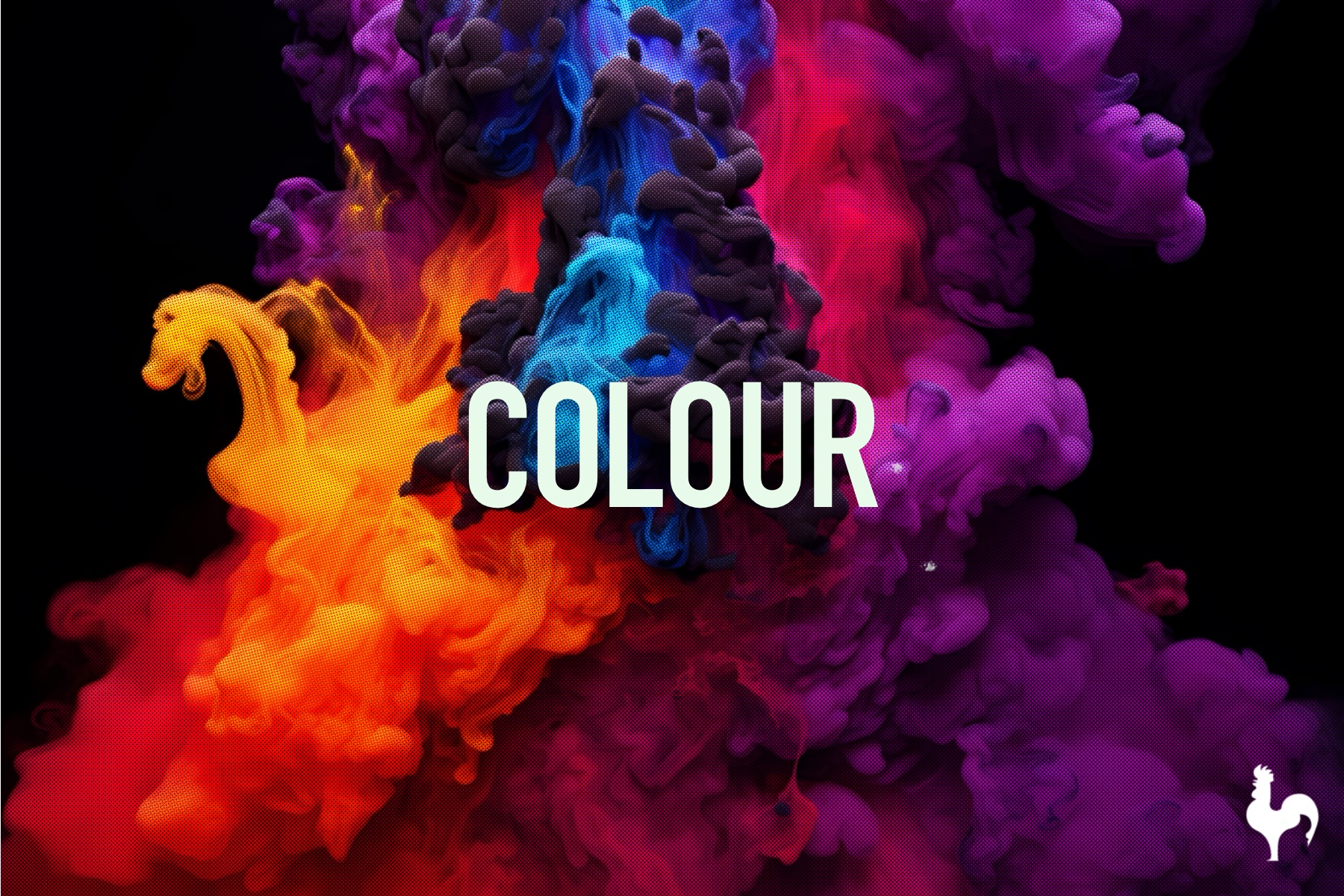In the digital era, where choices abound, marketers are tapping into this colour-coded language to influence purchasing behaviours.
Harnessing colour psychology isn’t just about aesthetics; it’s a strategic move rooted in neuroscience. By understanding how the brain processes colours, brands can tailor their messages, making them more resonant and compelling. But the choice of colour is not arbitrary—it’s based on a blend of science, culture, and brand narrative.
The potency of colour psychology extends beyond just branding. From website design to product packaging, colour choices can either make or break the consumer’s journey. As we delve into this colourful world, we’ll uncover the profound impact of each hue on marketing and conversions.
The Deep Dive into Colour Emotions
Red: The Attention-Grabber
Red is the universal sign of alert. From traffic lights to sale signs, it’s used to grab attention and signal importance. But its influence extends beyond just catching the eye; it stirs emotions, igniting feelings of passion, danger, and excitement.
In the world of e-commerce, red has been a favourite for call-to-action buttons. It’s not just because it stands out, but because it invokes urgency. Brands like Target and Netflix employ red to build a dynamic, energetic brand persona. However, its aggressive nature means it must be used judiciously to avoid overwhelming the viewer.
Yet, red’s versatility is its strength. While it can signify urgency in one context, it can evoke feelings of love and warmth in another. Think of the nuanced use of red in Valentine’s promotions or luxury brands—it’s less about the colour and more about the emotion it encapsulates.
Blue: The Trusted Friend
Walk into any corporate office, and you’ll likely be met with shades of blue. It’s the colour of professionalism, trust, and reliability. In the chaotic digital landscape, blue stands as a beacon of calm, stability, and trustworthiness.
Brands like Facebook, Dell, and Ford have built their identities around blue. They’re sending a subconscious message to their users—’You can trust us; we’re reliable.’ However, blue’s calming effect has another side—it can also be perceived as cold or indifferent if not complemented with warmer hues or engaging content.
Beyond trust, blue also resonates with feelings of serenity and introspection. It’s no wonder that wellness apps, meditation platforms, and healthcare brands often gravitate towards this hue. In every shade, from navy to sky blue, it offers a sense of familiarity and comfort.
Yellow: The Optimist
Yellow is the colour of sunshine, symbolising warmth, cheerfulness, and positivity. In marketing, it’s often used to evoke feelings of happiness, hope, and freshness. Brands like McDonald’s and Nikon employ yellow to capture attention and exude a youthful, vibrant energy.
But yellow’s strength is also its challenge. Its vibrancy can capture attention, but if overused, it can be overwhelming or even induce anxiety. That’s why it’s often used in tandem with neutral colours, ensuring it adds vibrancy without overpowering the design.
In some contexts, yellow also stands for caution, making it a dual-natured colour. Brands need to be aware of this duality, ensuring they’re harnessing its positivity without unintentionally evoking caution or concern.
Green: The Harmoniser
Green is the bridge between the warmth of yellow and the coolness of blue. It’s synonymous with nature, peace, and growth. In marketing, it signifies health, tranquillity, and freshness. Starbucks, Whole Foods, and Spotify, each in different sectors, all leverage green to resonate with their audience.
In the financial sector, green symbolises prosperity and growth. Brands like TD Bank and Fidelity use green to evoke feelings of financial security and wealth. On the flip side, green can also signify envy or inexperience, making its context crucial.
Yet, the universal appeal of green lies in its association with the environment. As sustainability becomes a global priority, green has become the go-to colour for brands emphasising eco-friendliness, organic ingredients, or green initiatives.
Purple: The Luxurious Enigma
Historically linked to royalty, purple embodies luxury, power, and ambition. It’s a rare colour in nature, making it distinct and memorable in marketing. Brands like Cadbury and Twitch have harnessed purple to distinguish themselves from the competition.
In the realm of luxury, purple evokes a sense of sophistication and exclusivity. It’s not just about being premium; it’s about being one-of-a-kind. However, its rarity also means it’s less familiar to the average consumer, making its use in mainstream marketing limited.
Yet, purple’s blend of the calmness of blue and the energy of red makes it versatile. Lighter shades like lavender evoke feelings of romance and nostalgia, whilst deeper shades resonate with mystery, luxury, and depth. It’s a colour that invites exploration, making it perfect for brands looking to intrigue and entice.
The Science Behind Colours and Conversion
Colours are not just about visual appeal; they play a crucial role in guiding user actions. From website navigation to completing a purchase, the strategic use of colour can enhance user experience, making the journey intuitive and engaging.
Studies have shown that users form an opinion about a product or website in just 90 seconds, and 90% of that opinion is based on colour alone. This underscores the importance of choosing the right colour palette, one that not only resonates with the brand’s identity but also aligns with user expectations and preferences.
But it’s not just about the primary brand colours. The secondary and tertiary colours, often used for CTAs, hyperlinks, and highlights, play a pivotal role in guiding user attention and actions. For instance, a study found that changing the colour of a CTA button from green to red resulted in a 21% increase in conversions. It’s these subtle tweaks, rooted in colour psychology, that can significantly impact user engagement and conversions.
Colour Stories from the Real World
Brands have long understood the power of colour, and many have fascinating tales of how they chose, changed, or fought for their signature hues.
Cadbury, the chocolate giant, didn’t just choose purple; they legally defended their right to it. Their distinct shade, Pantone 2685C, became so synonymous with their brand that they sought to trademark it, understanding the deep emotional and commercial value tied to it.
Tiffany & Co. is another brand with a colour story. Their iconic robin’s egg blue isn’t just a colour; it’s an experience, a promise of luxury, elegance, and timeless beauty. Over the decades, this colour has become as iconic as the brand itself, showcasing the enduring power of colour in branding.
Global Hues: Cultural Interpretations of Colour
As the business world becomes increasingly globalised, understanding the cultural connotations of colours is paramount. A colour that evokes trust in one culture might signify mourning in another.
For instance, while red is the colour of love and passion in the West, it’s a colour of luck, prosperity, and celebration in many Asian cultures. Similarly, while white signifies purity and peace in Western cultures, it’s a colour of mourning in many Eastern ones.
These cultural nuances extend beyond just primary colours. The shades, tints, and combinations all carry cultural baggage, making colour choices a complex task for global brands. It’s not just about translation; it’s about transcreation, ensuring the colour story resonates with every audience.
The Future is Colourful
The digital landscape is evolving, but the principles of colour psychology remain steadfast. As brands navigate the challenges of the digital age, from fleeting attention spans to information overload, colours will continue to play a pivotal role.
It’s not just about standing out; it’s about resonating, connecting, and converting. As technologies advance, from AR to VR, the canvas might change, but the art of using colours to tell stories, evoke emotions, and drive actions will remain as relevant as ever.
FAQs
How significant is the role of colour in influencing consumer behaviour?
Colour plays a pivotal role in shaping perceptions, evoking emotions, and influencing decisions. It can enhance brand recall, drive user actions, and even influence mood.
Are there universal colour rules that brands can follow?
While certain colour emotions are relatively consistent across cultures, it’s essential to consider local nuances, especially for global brands.
How often should brands revisit their colour strategy?
While consistency is crucial for brand recognition, it’s beneficial to periodically assess colour strategies, especially when rebranding or entering new markets.
What’s the next big thing in colour psychology for digital marketing?
As technology evolves, immersive experiences like AR and VR will offer new canvases for brands. Understanding how colours work in these spaces will be the next frontier.
Can I use multiple colours for my brand, or should I stick to one primary colour?
Brands can have a primary colour and several secondary colours. The key is consistency and ensuring the palette resonates with the brand’s identity and audience.
How do colours interact with other design elements like typography and imagery?
Colours should complement other design elements, creating a cohesive visual narrative. They can enhance readability, guide attention, and set the mood.
What are the emerging trends in colour psychology?
Biophilic design, drawing inspiration from nature, is on the rise. Muted, earthy tones and gradients are also gaining traction in digital design.





